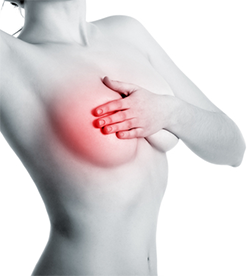Breast cancer – symptoms, diagnosis, treatment

Mammography is radiological breast examination. Mammography involves construction of a series of images of the mammary gland using X-rays. It is a very sensitive examination, allowing detection of changes in the breast structure down to a millimetre scale. Mammography is a safe technique and allows for an early diagnosis of breast cancer without the need for anaesthetization.
Preparation for examination
A doctor’s referral is required for the examination. If mammography or breast ultrasound examination were performed in the past, the results should be presented. On the day of examination, women should not use lotions, creams or deodorants with talcum powder.
Procedure
During the examination, two images of each breast are taken. Mammography should be performed between day 5 and day 10 of the menstrual cycle, when the breasts are less sensitive to touch. Breast compression during the examination is completely safe. The examination lasts several minutes, during which a radiologist positions the breast on a platform of the mammography unit, compresses it with a clear plastic paddle to hold it still, and then takes a mammographic image. Such breast compression reduces the dosage of X-ray radiation and allows to obtain a clear image of breast structure and potential changes.
If the mammography results indicate irregularities, the patient is referred for further examinations which may include a supplementary mammography, breast ultrasound examination, MRI or biopsy.
Examination schedule
For women at a higher risk of developing breast cancer (breast cancer in family members: mother, sister, daughter, BRCA 1 and/or BRCA 2 gene mutations), mammography should be performed every 6 months, alternately with an MRI. Additionally, breast ultrasound should be performed every 12 months as a supplementary examination.
According to breast cancer prophylaxis recommendations, women aged 50–69 should undergo mammography every 24 months. However, regardless of their age, women should also observe their breasts on their own and ask a doctor to examine them during their annual medical checkup.
Mammography should be performed in case any of the following worrying symptoms are present:
breast pain;
detection of a thickened area during breast self-examination;
nipple or skin retraction;
nipple discharge;
presence of a cyst;
breast asymmetry;
genetic predispositions.
It is recommended to consult a physician in case any of the above symptoms are positive.
Is the examination safe?
Mammography is completely safe. The radiation dose during the examination is similar to the dose absorbed during a dental x-ray or radiation present on aircrafts.
However, pregnancy is a counter indication for mammography.
Mammography and breast ultrasound
For a mammography examination to be effective, various diagnostic methods should be used and adjusted to the age of the patient and her breast built.
Mammography is currently considered as the best method for early detection of breast cancer in women aged over 40 and the most efficient screening test in women aged 50–69. It is a highly sensitive examination allowing to detect changes at an early advancement stage.
Early detection offers a high chance for complete recovery.
Breast ultrasound is recommended for young women, aged 20–40 years, or at any age as a supplementary examination.
BRASTER – AN EXCELLENT SUPPLEMENT TO OTHER DIAGNOSTIC METHODS
Braster examination, which can be performed every month is an excellent supplement to mammography. The device includes a patented liquid-crystal thermographic matrix, which can detect potentially alarming changes in the breast structure.
Zostaw swój numer, oddzwonimy i odpowiemy na Twoje pytania
I consent to the use of telecommunication end devices by BRASTER S.A. for commercial purposes and direct marketing, pursuant to Article 172 of the Act of July 16, 2004 – Telecommunications Law and the Act of July 18, 2002 on electronic provision of services. In particular, I consent to receiving incoming phone calls from BRASTER S.A. I declare that I have been informed that the above consent is voluntary and may be revoked at any time.
Strona http://braster.eu/nl realizuje sprzedaż jedynie na terenie Holandii. Jeżeli chcesz zrealizować zamówienie na terenie Polski przejdź na http://braster.eu/pl
I consent to the use of telecommunication end devices by BRASTER S.A. for commercial purposes and direct marketing, pursuant to Article 172 of the Act of July 16, 2004 – Telecommunications Law and the Act of July 18, 2002 on electronic provision of services. In particular, I consent to receiving incoming phone calls from BRASTER S.A. I declare that I have been informed that the above consent is voluntary and may be revoked at any time.
Your message was sent.
We will reply as soon as possible.
Raty PayU to możliwość zapłacenia za zakupy w ratach (od 3 do nawet 36)
Sign In
Create New Account